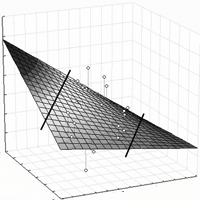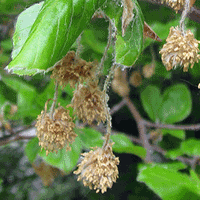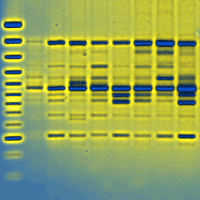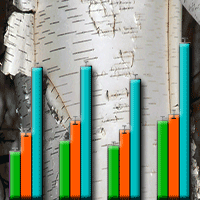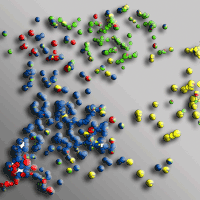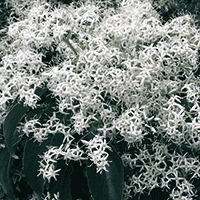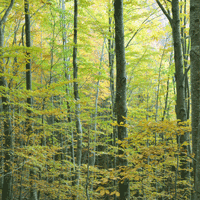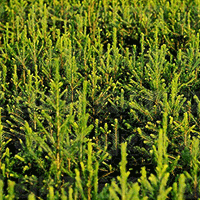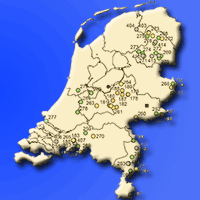
Growth, spring phenology and stem quality of four broadleaved species assessed in provenance trials in the Netherlands - Implications for seed sourcing
Joukje Buiteveld (1) , Hinke Wiersma (1), Maria-João Paulo (2), Inge Verbeek (1), Paul Copini (1)
iForest - Biogeosciences and Forestry, Volume 18, Issue 5, Pages 242-251 (2025)
doi: https://doi.org/10.3832/ifor4930-018
Published: Sep 22, 2025 - Copyright © 2025 SISEF
Research Articles
Abstract
Local seed sourcing from autochthonous tree populations is widely practiced for biodiversity conservation, as they are presumed to be adapted to local environmental conditions. Yet, autochthonous seed sources are not registered in the Netherlands for timber production, as these stands often exhibit poor stem quality due to their coppice history. Here, we study whether the performance of registered local seed sources from autochthonous origin (category “Source identified”) differs from local seed sources selected or improved for forestry purposes. We analyzed survival, growth, spring phenology, and stem form in four single-site provenance trials. In total, seeds from 74 provenances of four broadleaved species (Alnus glutinosa, Betula pubescens, Fagus sylvatica, and Quercus robur) were collected and planted in four provenance trials between 2008 and 2010. Provenance effects were consistently significant for budburst, whereas the effects on survival, growth, and stem form varied by species. Betula pubescens showed a 169% height difference between provenances at age 12, with several autochthonous provenances outperforming seed orchard material. In the other species, several autochthonous provenances performed equally well in terms of growth compared to seed sources in the “Tested” category. Differences in budburst timing were particularly evident in Fagus sylvatica and Quercus robur. In these trials, the autochthonous provenances were among the latest in flushing compared to the other local seed sources. Principal component analysis revealed strong correlations between growth and budburst, especially in Fagus sylvatica and Quercus robur, where earlier flushing was linked to greater height. This highlights potential trade-offs in selecting for both growth and late budburst. Overall, the study demonstrated that even within the ecologically uniform Dutch environment, genetic differences are present between local seed sources. We conclude that autochthonous provenances, despite exhibiting inferior phenotypic characteristics in situ due to past intensive silvicultural practice, can possess good growth and form characteristics, which makes them suitable for seed collection for both ecological and production purposes.
Keywords
Provenance Trials, Growth, Stem Form, Spring Leaf Phenology, Alnus glutinosa, Betula pubescens, Fagus sylvatica, Quercus robur
Authors’ Info
Authors’ address
Hinke Wiersma
Inge Verbeek
Paul Copini 0000-0002-5547-2609
Centre for Genetic Resources, The Netherlands, Wageningen University and Research, P.O. Box 47, 6700 AA, Wageningen (The Netherlands)
Biometris, The Netherlands, Wageningen University and Research, P.O. Box 47, 6700 AA, Wageningen (The Netherlands)
Corresponding author
Paper Info
Citation
Buiteveld J, Wiersma H, Paulo M-J, Verbeek I, Copini P (2025). Growth, spring phenology and stem quality of four broadleaved species assessed in provenance trials in the Netherlands - Implications for seed sourcing. iForest 18: 242-251. - doi: 10.3832/ifor4930-018
Academic Editor
Marco Borghetti
Paper history
Received: Jun 23, 2025
Accepted: Aug 28, 2025
First online: Sep 22, 2025
Publication Date: Oct 31, 2025
Publication Time: 0.83 months
Copyright Information
© SISEF - The Italian Society of Silviculture and Forest Ecology 2025
Open Access
This article is distributed under the terms of the Creative Commons Attribution-Non Commercial 4.0 International (https://creativecommons.org/licenses/by-nc/4.0/), which permits unrestricted use, distribution, and reproduction in any medium, provided you give appropriate credit to the original author(s) and the source, provide a link to the Creative Commons license, and indicate if changes were made.
Web Metrics
Breakdown by View Type
Article Usage
Total Article Views: 1960
(from publication date up to now)
Breakdown by View Type
HTML Page Views: 509
Abstract Page Views: 725
PDF Downloads: 675
Citation/Reference Downloads: 0
XML Downloads: 51
Web Metrics
Days since publication: 105
Overall contacts: 1960
Avg. contacts per week: 130.67
Citation Metrics
Article Citations
Article citations are based on data periodically collected from the Clarivate Web of Science web site
(last update: Mar 2025)
(No citations were found up to date. Please come back later)
Publication Metrics
by Dimensions ©
Articles citing this article
List of the papers citing this article based on CrossRef Cited-by.
References
Genetics and genetic resources - Genecology and adaptation of forest trees. In: “Encyclopedia of Forest Sciences” (Burley J ed). Elsevier, Oxford, UK, pp. 197-204.
Gscholar
Betula pendula, Betula pubescens and other birches in Europe: distribution, habitat, usage and threats. In: “European Atlas of Forest Tree Species” (San-Miguel-Ayanz J et al. eds). Publication Office of the European Union, Luxembourg, pp. 70-73.
Gscholar
Historia forestis: Nederlandse bosgeschiedenis [Historia forestis: Dutch forest history]. Landbouwhogeschool, Wageningen, the Netherlands, pp. 1060. [in Dutch]
Gscholar
Council Directive 1999/105/EC of 22 December 1999 on the marketing of forest reproductive material. European Union, Brussels.
Gscholar
Phenology, height increment, and cold tolerance of Alnus glutinosa populations in a common environment. Silvae Genetica 35: 205-211.
Gscholar
Wood-pasture in Dutch common woodlands and the deforestation of the Dutch landscape. In: “The Ecological History of European Forests” (Kirby KJ, Watkins C eds). CAB International, Wallingford, UK, pp. 53-62.
Gscholar
Alnus glutinosa in Europe: distribution, habitat, usage and threats. In: “European Atlas of Forest Tree Species” (San-Miguel-Ayanz J et al. eds). Publication office of the European Union, Luxembourg, pp. 64-65.
Gscholar
The second report on the state of the world’s forest genetic resources. FAO Commission on Genetic Resources for Food and Agriculture Assessments, Rome, Italy, pp. 229.
Gscholar
Forest and landscape restoration severely constrained by a lack of attention to the quantity and quality of tree seed: insights from a global survey. Conservation Letters 11 (4): e12424.
Gscholar
Hakhout - Suggesties voor het beheer [Coppice - Suggestions for management]. Stichting Bos en Hout, Nijmegen, the Netherland, pp. 55. [in Dutch]
Gscholar
Prüfung von Birkenherkünften und Einzelbäumen sowie Züchtung mit Birke [Testing of birch origins and individual trees as well as breeding with birch]. Forst-und Holzwirt 35: 81-90. [in German]
Gscholar
Internationaal herkomstonderzoek beuk in Nederland [International provenance research on beech in the Netherlands]. Report no. 286, Alterra, Wageningen, the Netherlands, pp. 36. [in Dutch]
Gscholar
Herkomstonderzoek beuk in Nederland [Provenance research on beech in the Netherlands]. CGN, Report no. 16, Wageningen, the Netherlands, pp. 29. [in Dutch]
Gscholar
Bos voor de toekomst. Uitwerking ambities en doelen landelijke Bossenstrategie en beleidsagenda 2030 [Forests for the Future: development of the ambitions and goals of the national Forest Strategy and policy agenda for 2030]. Ministry of Agriculture, Nature and Food Quality and IPO, Den Haag, The Netherlands, pp. 59.
Gscholar
Hakhout: historie en verschijningsvormen [Coppice: history and appearances]. Historisch Geografisch Tijdschrift 24 (1): 14. [in Dutch]
Gscholar
Inheemse bomen en struiken in Nederland en Vlaanderen: herkenning, verspreiding, geschiedenis en gebruik [Native trees and shrubs in the Netherlands and Flanders: identification, distribution, history and use]. Boom, Amsterdam, The Netherlands, pp. 376. [in Dutch]
Gscholar
Atlas wilde bomen en struiken: Landschappelijk groen erfgoed in de provincies van Nederland en Vlaanderen [Atlas of wild trees and shrubs: landscape green heritage in the provinces of the Netherlands and Flanders]. Pictures Publishers, Woudrichem, the Netherlands, pp. 720. [in Dutch]
Gscholar
Phenotypic trait variation measured on European genetic trials of Fagus sylvatica L. Scientific Data 5 (1): 180149.
CrossRef | Gscholar
Adaptive and plastic responses of Quercus petraea populations to climate across Europe. Global Change Biology 23 (7): 2831-2847.
CrossRef | Gscholar
Onderzoek aan herkomsten en nakomelingschappen van els (Alnus glutinosa, Alnus incana en Alnus cordata) [Research on provenances and progenies of alder (Alnus glutinosa, Alnus incana and Alnus cordata). De Dorschkamp, Wageningen, Netherlands, pp. 23. [in Dutch]
Gscholar
Series of international provenance trials of European beech. In: Proceedings from the “7th International beech symposium IUFRO Research Group”. Tehran (Iran) 11-16 May 2004. Research Institute of Forests and Rangelands - RIFR, IUFRO, Tehran, Iran, pp. 180.
Gscholar
Variation in temperature sum requirement for flushing of beech provenances. Silvae Genetica 44 (5/6): 343-346.
Gscholar
Macht die Herkunft den Unterschied? Ergebnisse der Nachkommenschaftsprüfungen von Stieleiche (Quercus robur L.) und Fichte (Picea abies (L.) Karst.) in Baden-Württemberg [Does the provenance make the difference? Results from progeny tests of pedunculate oak (Quercus robur L.) and Norway spruce (Picea abies (L.) Karst) in Baden-Wuerttemberg, Germany.]. Allgemeine Forst-und Jagdzeitung 188 (9-10): 153-168. [in German]
Gscholar

